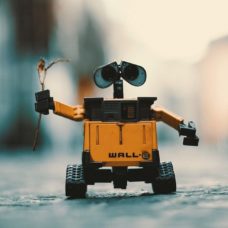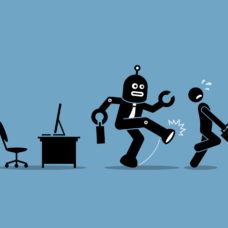The robot revolution is among us! At least it is in China, where automation is everywhere. With a new president, Donald J. Trump, talk of the glory days of America’s industrial revolution returning has begun. How did China become a global leader in new technology, and what can Trump learn from it?
 In the same amount of time that it took the U.S. to upgrade infrastructure such as repurposing the Philadelphia shipyard into the city’s airport, Chinese cities have transformed from desolated farm land to financial and technological centers. Increasingly, over the past 15 years or so, American fears over China’s ownership of a large part of debt from the U.S. have risen, seemingly alongside China’s government sponsored transformation into a global industrial tech power with increasingly competitive markets and bustling, new metropolitan city centers.
In the same amount of time that it took the U.S. to upgrade infrastructure such as repurposing the Philadelphia shipyard into the city’s airport, Chinese cities have transformed from desolated farm land to financial and technological centers. Increasingly, over the past 15 years or so, American fears over China’s ownership of a large part of debt from the U.S. have risen, seemingly alongside China’s government sponsored transformation into a global industrial tech power with increasingly competitive markets and bustling, new metropolitan city centers.
In the age of Trump, nationalist rhetoric frames China as a country that is taking advantage of American fair labor standards and trade policies to get ahead.
Mr. Trump’s solution to what he believes to be a lagging industry in the U.S. ignores the effort that the Chinese government has been investing in current, forward thinking tech and industrialization methods.
It is possible that China could surpass the U.S. economically, and if that happens, it will not be because of the money that we owe to them. It will be because of the country’s focus on innovation in factory culture and automation.
Here are 6 ways China is closing the Automation Gap:
1. Investment in Cleantech Brings Dividends
For years, tech industry insiders have recognized the rapid advancement of cleantech in China. In a 2011 report, Dallas Kachan notes the remarkable changes in infrastructure that have taken place in the last 15 years.
The evidence is hard to dispute. He concludes that these changes are “indicative of China’s new green order.” When the piece was written, the country had already formulated a five-year plan that placed “strategic emphasis on clean and green technologies as a cornerstone of China’s economic growth and improvement in standard of living.”
As China emerges as the cleantech capital of the world, the rate of venture capital investment deals in the country are climbing upwards as well. The country has quickly become competitive in an emerging industry thanks to massive investments in clean energy both at home and overseas.
2. Moving Towards Robot Culture Closes Automation Gap
China has made a shift to more cost-effective automation on factory floors, while the U.S. is lagging behind in the automation gap.
Meanwhile, the demand for cheap labor via cheap goods puts the US in an awkward position when pressuring China over climate control and human rights practices. Because of the cost of employing a US worker over an overseas worker, or a machine even, it is not likely that Trump’s “Made in America” tax incentives and penalties will bring manufacturing jobs back home as intended.
Most likely, it will encourage U.S. industry to follow China’s example and automate.
3. One Child Policy Leaves a Slim Workforce
The government’s focus on closing the automation gap is incentivized by more than the allure of foreign trade and profits for Factory Asia. Automation is also a direct response to the country’s shrinking workforce, a result of their now defunct “one child policy.”
In China, “the working-age population—defined as those from 15 to 59—fell for the first time in 2012, according to official figures, and has declined ever since.” As the population ages, the industry is turning to sophisticated robots that can save space, solve problems, and do more of the dangerous heavy lifting.
Already, the country has more robots and automated assistance than anywhere else in the world.
By 2019, “China will account for 40 percent of the global industrial robot market.”
4. Major Investments
China is on the forefront of robotics research and development, and its investment in the Chinese Association of Automation, of which currently there is no U.S. counterpart, constantly encourages innovation.
The CAA hosts integration with world-class universities and industry for commercialization opportunities.
This year, the CAA announced a study by researcher Dr. Zhijun Fu from Zhejiang University, which could totally transform the world of robotics. Dr. Fu and his team have figured out how to manipulate robots so that they can perform better in with nonlinear functions.
Essentially, the team has created a new kind of robot “brain” that can respond to a new control scheme that goes beyond standard linear robotics. As they explore various methods of artificial intelligence and robotics design, they prove to be leaders of the next frontier of automation.
5. Government Support & Change in Culture
Trends in Asia towards government incentives in tech are picking up throughout the entire region. China has invested billions of dollars in upgrading its factories by focusing on closing the automation gap. They’ve done this by using better, more advanced robots. The government hopes that by looking to the future of robotics, the country will be able to have a firm hold on this developing industry in the coming years.
It is important to note however, that robotics are in fact an expensive endeavor.
The financial benefits of automation do not always make up for the costs of labor, and are “unlikely to be enough to justify outsourcing the part to China, once all the other costs and risks are taken into account.”
At the same time, “the government is enacting new labor laws that give greater rights to workers, requiring, for example, that companies pay laid-off workers one month’s salary in severance for every year that they worked.”
The work culture in Chinese factories is changing for the better with wages steadily rising. The need for more advanced automation is also improving the skill levels of workers, who are turning to work that is more geared toward engineering and mechanics so that they can keep up with their robotic helpers. This is a win-win for the future of innovation in the country.
6. Robots Can Help us Save the Environment
The rising costs of electricity and international pressure on climate change and human rights standards serve as an incentive for the development of alternative, clean energies. A Boston Consulting Group study explains how the cleantech and automation investments are linked to electricity prices, which have “surged by 15 percent since 2010.”
Industrial land, too is not as cheap as it used to be, nor are coal and natural gas.
These economic forces are leading the government to take more active measures in order to maintain their foothold in the global industrial economy.
How to Make America Great
Mr. Trump’s plan to re-industrialize the nation with more fracking and product assembly will not be effective in a world that is rapidly looking to the future for solutions to tech innovations.
If the U.S. really wants to be great at industry again, the country needs to invest more in closing the automation gap and producing clean energy.
Chinese labor is not as cheap as it used to be, and with that option off the table under new domestic policies, a machine will still be cheaper than employing a person, especially considering that any sort of major wage increases are unlikely under a Trump presidency.
Government sponsored cleantech programs and incentives, as well as wider education initiatives for engineers, scientists, manufacturers are good ways to start competing with China’s rapidly changing industry and rapidly closing automation gap.


















How to delete bing history completely http://deletebinghistory.com first install the bing web browser and learn more about.
As you might guess, a great deal of assignments help abstraction fails to make the cut for me.
While they obviously don’t hope to solve this by itself manufacturing innovative organizations with a wide scope of pertinent players, for instance, will be basic, or individual laborers should lead the pack in attempting to close the approaching skills gap.
I think they big thing here is the fact that we, as writers, now utilize the web to get our thoughts onto ‘paper’ and we write for others to read.